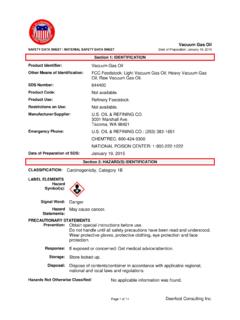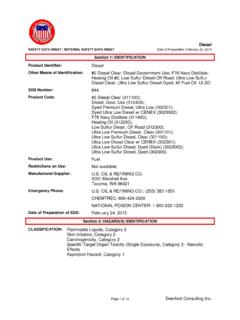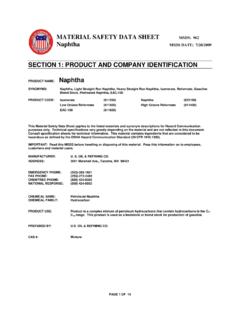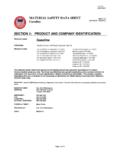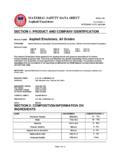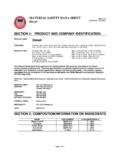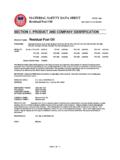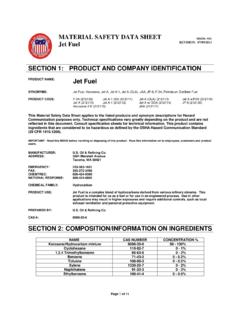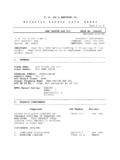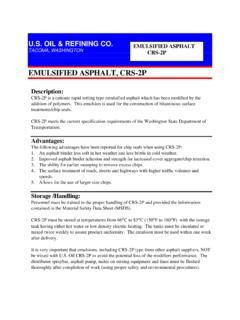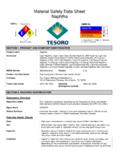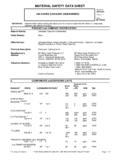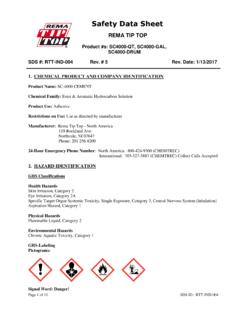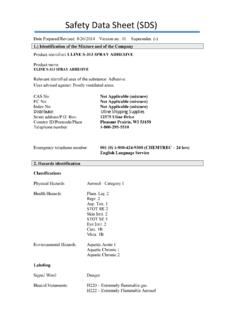Transcription of Jet Fuel SAFETY DATA SHEET / MATERIAL SAFETY …
1 Jet Fuel SAFETY data SHEET / MATERIAL SAFETY data SHEET Date of Preparation: October 14, 2014 Page 1 of 13 Deerfoot Consulting Inc. Section 1: IDENTIFICATION Product Identifier: Jet Fuel Other Means of Identification: Jet Fuel; Kerosene; Jet A; Jet A-1; Jet A (DLA); JAA; JP-8; F-34; Petroleum Distillate Fuel. SDS Number: 941 Product Code: F-34 (212132); JAA (212117); Jet A-1 (50) (212111); Jet A-1 (212112); Jet A (DLA) (212113); Jet A (212110); Jet A w/FSII (212116); Jet A w/ SDA (212114); JP-8 (212130). Product Use: Jet Fuel is a complex blend of hydrocarbons derived from various refinery streams. This product is intended for use as a fuel or for use in an engineered process. Use in other applications may result in higher exposures and require additional controls, such as local exhaust ventilation and personal protective equipment.
2 Restrictions on Use: Not available. Manufacturer/Supplier: OIL & REFINING CO. 3001 Marshall Ave. Tacoma, WA 98421 Emergency Phone: OIL & REFINING CO.: (253) 383-1651 CHEMTREC: 800-424-9300 NATIONAL POISON CENTER: 1-800-222-1222 Date of Preparation of SDS: October 14, 2014 Section 2: HAZARD(S) IDENTIFICATION CLASSIFICATION: Flammable Liquids, Category 3 Skin Irritation, Category 2 Germ Cell Mutagenicity, Category 1B Carcinogenicity, Category 1A Toxic to Reproduction, Category 2 Specific Target Organ Toxicity (Single Exposure), Category 3 - Narcotic Effects Aspiration Hazard, Category 1 Jet Fuel SAFETY data SHEET / MATERIAL SAFETY data SHEET Date of Preparation: October 14, 2014 Page 2 of 13 Deerfoot Consulting Inc.
3 LABEL ELEMENTS Hazard Symbol(s): Signal Word: Danger Hazard Statements: Flammable liquid and vapor. Causes skin irritation. May cause genetic defects. May cause cancer. Suspected of damaging fertility or the unborn child. May cause drowsiness or dizziness. May be fatal if swallowed and enters airways. PRECAUTIONARY STATEMENTS Prevention: Obtain special instructions before use. Do not handle until all SAFETY precautions have been read and understood. Keep away from heat, sparks, open flames, and hot surfaces. No smoking. Keep container tightly closed. Ground/bond container and receiving equipment. Use explosion-proof electrical, ventilating, and lighting equipment. Use only non-sparking tools.
4 Take precautionary measures against static discharge. Avoid breathing mist, vapors, or spray. Wash thoroughly after handling. Use only outdoors or in a well-ventilated area. Wear protective gloves, protective clothing and eye protection. Response: If swallowed: Immediately call a poison center or doctor. If on skin (or hair): Take off immediately all contaminated clothing. Rinse skin with water/shower. If inhaled: Remove person to fresh air and keep comfortable for breathing. Call a poison center or doctor if you feel unwell. Do NOT induce vomiting. If skin irritation occurs: Get medical advice/attention. Wash contaminated clothing before reuse. In case of fire: Use dry chemical, CO2, water spray or regular foam to extinguish.
5 Storage: Store in a well-ventilated place. Keep container tightly closed. Keep cool. Store locked up. Disposal: Dispose of contents/container in accordance with applicable regional, national and local laws and regulations. Jet Fuel SAFETY data SHEET / MATERIAL SAFETY data SHEET Date of Preparation: October 14, 2014 Page 3 of 13 Deerfoot Consulting Inc. Hazards Not Otherwise Classified: No applicable information was found. Ingredients with Unknown Acute Toxicity: None. This MATERIAL is considered hazardous by the OSHA Hazard Communication Standard, (29 CFR ). Section 3: COMPOSITION / INFORMATION ON INGREDIENTS Hazardous Ingredient(s) Common name / Synonyms CAS No. % Kerosene (petroleum) Kerosine 8008-20-6 90 - 100 Naphthalene Not available.
6 91-20-3 0 - , - 1, 1 - 3* Benzene, 1,2,4-trimethyl- 1,2,4-Trimethylbenzene 95-63-6 0 - , - 1, 1 - 2* Benzene, dimethyl- Xylene 1330-20-7 0 - , - 1, 1 - 2* Cyclohexane Not available. 110-82-7 0 - , - 1* Benzene, methyl- Toluene 108-88-3 0 - , - * Benzene, ethyl- Ethylbenzene 100-41-4 0 - , - * Benzene Not available. 71-43-2 0 - , - * * Multiple concentration ranges are listed due to production variability, and in conformance with Canadian WHMIS requirements. Section 4: FIRST-AID MEASURES Inhalation: If inhaled: Remove person to fresh air and keep comfortable for breathing. If symptoms persist, get medical attention/advice. If breathing or the heart stops, trained personnel should immediately begin artificial respiration (AR) or cardiopulmonary resuscitation (CPR) respectively.
7 Get medical attention immediately. Acute and delayed symptoms and effects: May cause drowsiness or dizziness. May cause respiratory irritation. Signs/symptoms may include cough, sneezing, nasal discharge, headache, hoarseness, and nose and throat pain. Excessive inhalation may cause headache, dizziness, confusion, loss of appetite and/or loss of consciousness. Skin Contact: If on skin (or hair): Take off immediately all contaminated clothing. Rinse skin with water/shower for at least 15 minutes. If skin irritation occurs: Get medical advice/attention. Wash contaminated clothing before reuse. Acute and delayed symptoms and effects: Causes skin irritation. Signs/symptoms may include localized redness, swelling, and itching.
8 Eye Contact: If in eyes: Rinse cautiously with water for at least 15 minutes. Remove contact lenses, if present and easy to do. Continue rinsing. If symptoms persist, get medical attention/advice. Acute and delayed symptoms and effects: May cause eye irritation. Signs/symptoms may include redness, swelling, pain, tearing, and blurred or hazy vision. Jet Fuel SAFETY data SHEET / MATERIAL SAFETY data SHEET Date of Preparation: October 14, 2014 Page 4 of 13 Deerfoot Consulting Inc. Ingestion: If swallowed: Do NOT induce vomiting. Immediately call a poison center or doctor. If vomiting occurs naturally, have victim lean forward to reduce the risk of aspiration. Never give anything by mouth to an unconscious person.
9 If breathing or the heart stops, trained personnel should immediately begin artificial respiration (AR) or cardiopulmonary resuscitation (CPR) respectively. Get medical attention immediately. Acute and delayed symptoms and effects: May be fatal if swallowed and enters airways. May cause gastrointestinal irritation. Signs/symptoms may include abdominal pain, stomach upset, nausea, vomiting and diarrhea. Note to Physicians: Symptoms may not appear immediately. Section 5: FIRE-FIGHTING MEASURES NFPA 704 SUITABLE/UNSUITABLE EXTINGUISHING MEDIA Suitable Extinguishing Media: Small Fire: Dry chemical, CO2, water spray or regular foam. Large Fire: Water spray, fog or regular foam. Move containers from fire area if it can be done safely.
10 Unsuitable Extinguishing Media: Do not use straight streams. SPECIFIC HAZARDS Flammable liquid and vapor. Will be easily ignited by heat, sparks or flames. Vapors may form explosive mixtures with air. Vapors may travel to source of ignition and flash back. Most vapors are heavier than air. They will spread along ground and collect in low or confined areas (sewers, basements, tanks). Vapor explosion hazard indoors, outdoors or in sewers. Runoff to sewer may create fire or explosion hazard. Containers may explode when heated. Many liquids are lighter than water. If tank, rail car or tank truck is involved in a fire, ISOLATE for 800 meters (1/2 mile) in all directions; also, consider initial evacuation for 800 meters (1/2 mile) in all directions.
